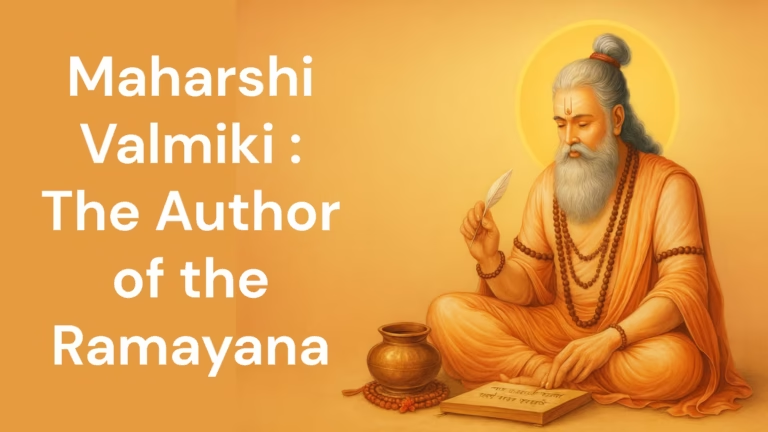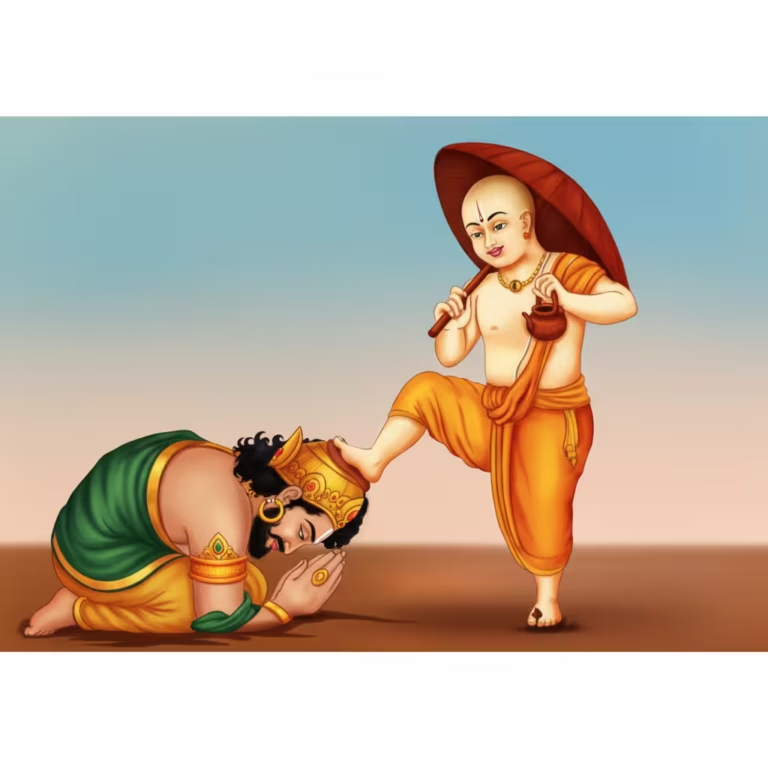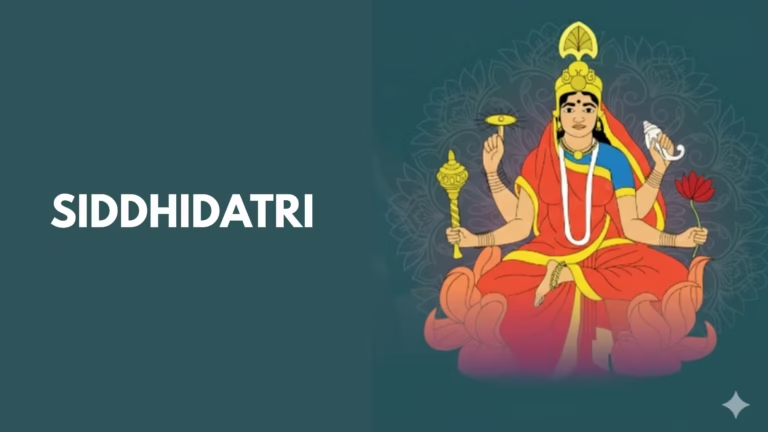As the eighth venerable form in the Navadurga sequence, Maa Mahagauri embodies the serene, benevolent, and sin‑dispelling current of Shakti. Within the Shakta tradition the primordial Power (Adi‑Shakti) is described through many emanations, whose scriptural roots appear across the Devi‑Mahatmya (of the Markandeya‑Purana lineage), the Devi‑Bhagavata Purana, the Shiva‑Purana, and other Shakti‑centric texts. The Mahagauri principle is that aspect of the Primordial Power which plants in the seeker the samskara of inner purification, peace, fortitude, and inward light.
This Life‑Charit presents a Purana‑based exposition of the name‑etymology and import, origin‑view, iconography, divine work (lila), worship discipline, fruits of practice, dharma‑ethic, and Mahagauri’s place in the Navadurga sequence—so that the devout reader receives fact‑true, scripture‑anchored, and practical understanding together.
Name‑Etymology and Import
“Mahagauri” is the union of two words: “Maha” (supreme, exceedingly great) and “Gauri” (fair, radiant, pure; the gentle, auspicious form of Parvati/Uma). In the Purana tradition, “Gauri” signifies Parvati’s serene, benevolent modality; “Mahagauri” points to the parama‑serenity and supreme purity through which the seeker’s impurities are washed away and the mind becomes placid and luminous.
The focus of the name is to underline the calm radiance of the Devi: parallel to the fierce forms that subdue adharma, the Mahagauri aspect continuously purifies within and bestows compassion.
Origin‑View: The Devi Principle and Mahagauri
The Puranic corpus speaks of Adi‑Shakti as the Mahāmāyā of the Supreme—through whom the functions of creation, sustenance, and dissolution, the activation of divine works, and the safeguarding of dharma proceed. In the Devi‑Mahatmya (Markandeya‑Purana lineage) the Goddess manifests multiple forms to overthrow demons and protect devotees; the Devi‑Bhagavata Purana elaborates various modalities of Shakti, their worship, and fruits of practice.
Within this sweeping scriptural horizon, Mahagauri symbolizes the graceful bestowal of purity and the light of inner serenity. She teaches that Power is not only fierceness; it is also peace and well‑being, wherein the grime of the mind is cleansed and gladness with steadiness arises.
Iconography: Arms, Vehicle, and Emblems
Puranic hymns, later stotras, and visual traditions portray Mahagauri as radiantly fair and deeply serene. The principal traits remembered across traditions include:
- Complexion and Attire: Fair/white complexion; white garments and ornaments—images of purity and peace.
- Mudras/Emblems: Varada (boon‑giving) and Abhaya (fear‑dispelling) mudras; and in different sources a kamandalu/pot, trishula/damaru, or flower/garland—signifying the balance of nourishing grace and resistance to adharma.
- Vehicle: Many traditions recall the bull (Nandi) or the lion—subtle marks of Shaiva affiliation and emblematic fearlessness.
- Aura: A calm, luminous nimbus—a metaphor for inward purity and grace.
Note that numbers of arms, specific emblems, or vehicle may vary by text and tradition. The scriptural intent is the functional symbolism—the harmony of sustenance and subjugation—not rigid numeric uniformity.
Parvati’s Austerities, Gauri’s Grace, and the Meaning of Mahagauri
Across Shaiva‑Shakta poetry and Puranic narrative, we meet the Himalaya’s daughter Parvati performing austere tapas, choosing Shiva as her lord, and establishing a dharmic householder’s life—episodes narrated in the Shiva‑Purana, Devi‑Bhagavata, and allied sources. Within these streams, the name Gauri widely denotes Parvati’s gentle, auspicious form; “Mahagauri” recalls the summit of serenity and purity where, by the synergy of tapas and grace, the mind’s coverings are fully washed away.
The scriptural signal here is clear: the aim of Shakti‑worship is not merely external accomplishments but inner cleansing; only then do the capacities for household dharma, service to the world, and steadfast upkeep of dharma ripen. Mahagauri is the remembrance of this complete (maha) purification.
Divine Work (Lila): The Stream of Purity and Grace
The Puranas teach that the Devi’s various emanations arise for divine works and the welfare of beings. While the fierce forms quell unrighteousness, the Mahagauri principle pours a stream of purification—dissolving inner defilements (rāga‑dveṣa, anger, heedlessness, egoism) and ushering in gladness and fortitude.
This lila is not mere story: it is a map of inner sādhanā. By the Devi’s grace the grime of the mind is washed, and the seeker becomes stable on the path of dharma.
Scriptural Worship: Core Observances and Discipline
The foundations of Shakti‑upāsanā are mantra, dhyāna, stotra‑recitation, and purity of conduct. In the traditional Navadurga cycle, Mahagauri’s worship aligns with the eighth day (asṭamī), though minor variations of calendric practice occur across lineages. Scriptural priorities include:
- Purity and Resolve: Truthfulness, non‑injury, restraint, sāttvika diet; purity of thought, speech, and action.
- Recitational Lineage: Reading of the Devi‑Mahatmya (Durga‑Saptashati lineage), Devi‑stotras, and japa of guru‑given mantra—as per the ācārya’s instruction.
- Meditation: Contemplation of Mahagauri’s serene, grace‑bestowing image; remembering Varada/Abhaya mudras to cultivate fearlessness and mental composure.
- Invocations, Offerings, and Arati: Always within scriptural bounds; avoid ostentation—inner purity is supreme.
The Puranic emphasis is that the essence of worship is purified conduct; externals bear fruit only when inner practice is firm.
Fruits of Practice: Scriptural Assurances
The fruits associated with Mahagauri‑upāsanā are primarily inner purification and a placid, luminous mind. The core outcomes remembered in tradition are:
- Mental Clarity and Peace: Diminishing of fear, anger, jealousy, and hatred; emergence of cheerfulness and steadiness.
- Fortitude and Gentleness: Soft speech, restraint, forbearance—qualities that stabilize household dharma.
- Discernment and Truthfulness: Sharpened discrimination; performance of duties aligned with truth and justice.
- Removal of Obstacles: Soothing of inner/outer hindrances; continuity of practice.
- Civic‑Minded Virtue: Extending personal sādhanā into service, compassion, and justice within family and society.
These fruits stabilize over the long term when practice is regular, scripture‑aligned, and guided by a competent guru.
Place of Mahagauri in the Navadurga Sequence
The Navadurga—nine contemplative modalities of Shakti—lead the seeker through the ascending arc of purification, tapas, valor, insight into creation, maternal compassion, heroic vigor, removal of darkness, purification‑grace, and integrative siddhi. In this sequence Mahagauri, the eighth, anchors the central sentiment of purification‑grace: after the fierce samskaras of the preceding stage, the seeker settles into steady serenity and cheer and moves toward the final integration embodied by Siddhidatri.
Calendric/worship variations across lineages may exist, yet the scriptural purport—the harmonized whole of the Devi‑principle—remains unchanged.
Dharma‑Ethic: The Practical Message of Purification‑Grace
Mahagauri teaches that the aim of life‑practice is not only outer attainments but inner purity, flowering through truth, compassion, non‑injury, and restraint. Three guiding maxims:
- Self‑Governance: Reining in attachment to sense‑objects, anger, and envy; practicing sāttvika habits.
- Duty‑Performance: Upholding responsibilities in home, work, and society with prudence and industriousness.
- Service to the World: Extending the serenity of the heart into service, charity, and justice.
When this purification‑grace descends into daily life, the seeker finds abiding well‑being, and society moves toward durable order—the practical consummation of the Mahagauri principle.
What Not to Do in Purana‑Based Worship
- Unscriptural Procedures: Avoid esoteric mantra‑rituals or tantric processes without proper initiation and guidance.
- Ostentation: Prefer cleanliness, truth, and compassion over display and luxury.
- Unwarranted Claims: Do not assert what lacks clear scriptural grounding; seek authoritative references first.
Frequently Asked Questions (FAQ)
1) Is Mahagauri explicitly mentioned in the Puranas?
The serene/gentle modalities of Shakti are elaborated in the Devi‑Bhagavata Purana and other Shakti‑centric texts. The Navadurga tradition’s “Mahagauri” crystallizes these scriptural streams into a venerated contemplative form.
2) Is the bull the only vehicle of Mahagauri?
Visual and hymnological traditions recall both the bull and the lion. The intent is to indicate fearless serenity and Shaiva affiliation. Variations in vehicle, emblems, or arm‑count are symbolic of functions, not rigid numerics.
3) Does Mahagauri bestow a specific boon?
Traditionally Mahagauri is associated with purification‑grace and boon/fear‑dispelling—i.e., the strength for mental composure and dharma‑aligned duty. Folk lines may speak of household peace and prosperity; give primacy to scripture and clean conduct.
4) Is there an obligatory text for worship?
The Devi‑Mahatmya (Durga‑Saptashati lineage), Devi‑stotras, and guru‑given mantra‑japa are time‑tested and safe. Detailed counts/nyasas/rites should always follow guru‑instruction.
Teaching Takeaway: Strength in Peace
Mahagauri proclaims that peace is not weakness—it is the gentle face of Power. With scripture‑aligned practice, the mind is cleansed; sweetness graces speech, patience steadies action, and discernment guides choices—nourishing the roots of family and society.
Maa Mahagauri is the current of Shakti that installs purification‑grace, serenity, and forbearance as durable samskaras in the seeker’s life. In the lineages of the Devi‑Mahatmya and the Devi‑Bhagavata Purana, this gentle form teaches that Power is not only demon‑subjugation but also devotee‑welfare and the gladness of mind. The heart of worship is a clean mind, scripture‑reading, and obeying the guru’s guidance—the path to lasting peace, duty‑steadfastness, and meaningful living.
Further reading: Maa Mahagauri (Book) — https://amzn.to/42f7h56



